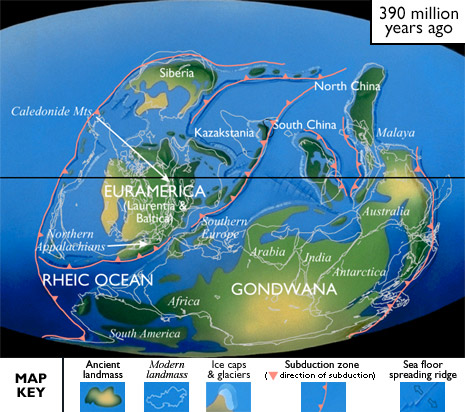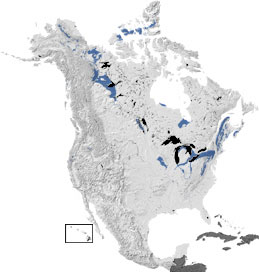the Devonian - 417 to 354 Million Years Ago
|
See the Devonian in: Or jump to another period: |
Links to more about the Devonian
Collecting and Legalities | Research and Collections | Organizations | Education and Exhibits | Research and Collections | Resources
Collecting and LegalitiesResearch and CollectionsWhere to Collect Fossils (showing 1 of 1 listings)
Penn Dixie Paleontological and Outdoor Education Center: A natural history center, where visitors can collect their own trilobites. The web page includes information on how to get to the site, fossils which can be found there, and other information.
Organizations(showing 1 of 1 listings)
The Natural History Museum, London's conodont collection: This database gives broad information about discrete collections within the conodont collection housed at the NHM. Generic, specific and subspecific names are included in the database, but the data is being updated regularly. As a result, the database is best searched by name of donor/collector/publisher or by geological period. Links to images are included with some collections.
Education and ExhibitsParks (showing 3 of 3 listings)
Falls of the Ohio State Park: The 386-million-year-old fossil beds in the park are among the largest naturally exposed Devonian fossil beds in the world.
Miguasha Park, Quebec, a Canada World Heritage Site: The fossiliferous beds of the Escuminac Formation yield over 21 species of Devonian fish, including beautifully preserved placoderms. This site provides a short description and some photos.
Miguasha National Park: This site provides all one needs to know before visiting the park -- its fossils, services, accomodations, etc.
Societies and Clubs (showing 1 of 1 listings)
KYANA Geological Society - Louisville, Kentucky: We are a non-profit educational organization, which was founded in 1961, to promote the interests of geology, minerals, fossils, and lapidary arts in Kentucky and Southern Indiana.
Museums (showing 3 of 3 listings)
Burpee Museum of Natural History: The mission of Burpee Museum of Natural History is to inspire all people to engage in a lifetime of learning about the natural world.
Garvies Point Museum official website: Garvies Point Museum and Preserve is located on Long Island's north shore in New York State. We are a center for regional geology research. Our exhibits deal with regional (Long Island and New York State) geology, fossilization and minerology and the ehnography and archaeology of northeastern Native Americans. Our exhibit "Drifitng Lands and Ancient Seas" details the geology of New York State coordinated with plate tectonics.
Two Medicine Dinosaur Center: The Two Medicine Dinosaur Center is located in the Bynum-Choteau area of Montana, along the Rocky Mountain front. This area is noted worldwide for its spectacular paleontological discoveries, geological exposures, wildlife habitat, and Native American historical and archaeological sites. The Dinosaur Center is situated in this impressive area to provide hands-on programs for the general public and an interactive museum to showcase our findings. Professional researchers and instructors provide informative and entertaining experiences for all ages and interests, and programs are conducted at active research sites allowing interested persons the opportunity to experience real dinosaur paleontology.
Research and CollectionsVirtual Exhibits (showing 3 of 11 listings)
Virtual Museum of Fossils: Geosciences, at Georgia's Valdosta State University, presents an interactive virtual museum of invertebrate and vertebrate fossil specimens. Explore the collection by animal, or by time period from Precambrian to Quaternary. Maps are detailed and include ecosystem distribution. Fossil photographs, many showing multiple views, list information about where the fossil was found, and how it is categorized taxonomically. Some pages feature a drawing of the animal's skeleton showing the fossil bone in red.
The Third Planet - a walk through geologic time: This virtual exhibit offers a tour of the Milwaukee Public Museum's geology exhibits, depicting the continuing evolution of the Earth from the Precambrian to present.
Who's Who at Red Hill: This website describes the geology and outstanding fossil record of this Late Devonian fossil site located in central Pennsylvania.
Physical Exhibits (showing 2 of 2 listings)
Fossil and Prairie Center: This nature center in Rockford, with native prairie, ponds and wetlands, also has exposures of Devonian rocks containing the fossils of marine invertebrates. Fossil collecting for private use is free to the public.
Robert M. Linsley Museum at Colgate University: The Robert M. Linsley Museum exhibits fossils, minerals, rocks, and the geology of New York State. We are fortunate to have some exceptional specimens on display, including eurypterids, Dipleura trilobites, gems, large mineral clusters, and scores of Herkimer "diamonds." A mural painted by local artist Rachel Amann depicts life in Hamilton during the Devonian period when local shales and siltstones accumulated. The museum is open during regular business hours (8 am- 5 pm) Monday-Friday.
ResourcesResearchers (showing 3 of 4 listings)
University of Iowa Paleontology Repository: The UI Paleontology Repository is home to over a million fossils from all over the world and from all time periods, and is used for research and teaching. We also provide education services, hands-on tours around the collections and geology exhibits for schools and community groups, and fossil identification and collection care services.
University of Kansas Paleobotanical Collection: Collection of fossil plants currently housed at the University of Kansas.
Dr. Thomas W. Kammer: Specialty: Evolutionary paleoecology of Paleozoic crinoids, plus lithostratigraphy, biostratigraphy, and sequence stratigraphy of marine Mississippian rocks in the east-central United States. Field areas include West Virginia, Kentucky, Indiana, Illinois, Missouri, and Iowa.
Ongoing Research Projects (showing 3 of 3 listings)
Sam Noble Oklahoma Museum of Natural History: On the campus of the University of Oklahoma in Norman. One of the finest university-based museums in the nation, with an active Paleontology research program and extensive collections.
Vertebrate Paleontology Laboratory, UT: The University of Texas Vertebrate Paleontology Laboratory houses one of the 10 largest collections in North America, and it supports one of the Nation's largest graduate education programs in paleontology. It also supports public exhibits at the Texas Memorial Museum.
Carnegie Museum: Invertebrate Paleontology Section: The Carnegie Museum of Natural History Section of Invertebrate Paleontology has more than 100 years of research, field work, educational outreach (PALS), and exhibits on Phanerozoic life. Our collections number more than three-quarters of a million specimens with some 11,000 type and figured specimens published in more than 300 professional publications. Our type and collection strengths are concentrated in the Lower and Upper Paleozoic rocks of the Appalachians, mid-continent, and western Interior Seaway.
Image Collections (showing 3 of 4 listings)
Falls of the Ohio Fossil Photos on Facebook: A collection of photographs of fossils taken at the State Park.
Falls of the Ohio Fossil Photos: Indiana Memory Project: This archive contains several photos of fossils from the Falls of the Ohio. Do an advanced search for "fossil" to find the images.
Michigan Basin Specimen Database: This site showcases Michigan Basin fossils from the private collections of Friends of the University of Michigan Museum of Paleontology and select specimens from the University of Michigan collection, including type specimens.
Courses and Lectures (showing 1 of 1 listings)
Paleogeography of the Southwestern U.S.: The paleogeography of the southwestern U.S. from 1.8 billion years ago to 10 million years ago. Text and images by Dr. Ron Blakey from Northern Arizona University.
Field Guides (showing 2 of 2 listings)
Fossil Cephalopods in Utah: A reference to help provide information on the identity, biostratigraphy and location of fossil cephalopods found in the state of Utah.
Devonian Corals of the Falls of the Ohio and Surrounding Areas: Descriptions and photos of some of the corals to be found at the Falls of the Ohio State Park.
Databases (showing 3 of 4 listings)
New Mexico Museum of Natural History and Science Web-based Paleo-database Home Page: Search the fossil collections of the New Mexico Museum of Natural History and Science. Listings by Kingdom down to species, era, epoch, group, formation, country, New Mexico county, and map ID. Many listings contain images of the fossils (including all holotypes.)
The Paleointegration Project: The PaleoIntegration Project (PIP) is facilitating interoperability between global-scale fossil and sedimentary rock databases (e.g. The Paleobiology Database and the Paleogeographic Atlas Project), enabling a greater understanding of the life, geography and climate of our planet throughout the Phanerozoic. Databases can be searched via text and interactive maps, and by any combination of age, location, or content. Results can be plotted on present- and paleo- maps or downloaded for detailed analyses.
Fossils in My Back Yard: Explore a geologic map of Iowa, county by county, to see lists and photos of fossils in the collections of the University of Iowa Paleontology Repository.
Annotated Bibliographies (showing 1 of 1 listings)
Bibliography of Paleobotany: A bibliographic database of paleobotany including more than 56,000 entries. It also includes references on Antarctic geology and paleontology and citations on Women in Science.
Maps (showing 1 of 1 listings)
Paleogeography and Geologic Evolution of North America: The images presented here show the paleogeography of North America over the last 550 million years of geologic history.
General Reference (showing 3 of 3 listings)
Maine State Fossil, Pertica quadrifaria: Fact sheet describing Maine's state fossil, the early land plant Pertica quadrifaria.
Fossils In Death Valley National Park: The paleontology, geology and natural wonders of Death Valley National Park (and more); many images of fossils; field trips; paleontology links, plus links to Death Valley.
List of Dinosaurs: This dinosaur listing is data-packed and can be sorted by dinosaur length, weight, time period, etc.

